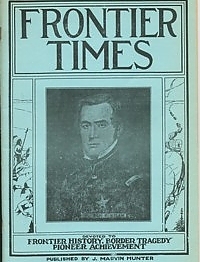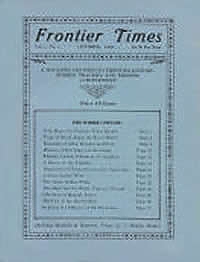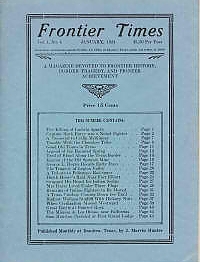By using our website, you agree to the use of cookies as described in our Cookie Policy
Magazines & Instant Downloads
Vol 10 No. 08 - May 1933
On the Cover – Ben Milam
The Hero of San Antonio
Story of Benjamin Milam, patriot, soldier in the war of 1812, prisoner, adventurer, trader, and hero of San Antonio.
Further Mentions: General A. B. Wabell, an Englishman; Judge Ellis; Dr. Beale; Capt. Collinsworth; Milani; Judge Burnet; the Verimendi House;
Davis Mountains-Big Bend Roundup
By Barry Scobee, Fort Davis, Texas. The cattlemen and cowboys of the Davis Mountains and Big Bend country wore good natured grins of contentment in the first years of the 1880's, for there was plenty of grass and water. Then something happened, with the result that the first great general roundup of cattle ever to be held in this region took place, in August, 1886. Prior to the general big roundup of 1886 there had been roundups by individual owners and by a few owners joining together. But so many cattlemen from the eastward had pushed into the Davis mountains in 1885 that by 1886, which was a drouth year, the range was grazed down in places to the pebbles, and the watersprings were crowded with bawling cattle. The year 1885 had been dry also, and with short water and short grass, the winter of 1885-86 saw scrawny cattle drift before the cold north winds into the south away from the Davis highlands into the Big Bend region. This situation triggered the massive roundup, and this is the account.
Further Mentions: the Chisos, the Chinates, the Glass mountains, Delawares, Eagles and Barillos; Judge David Merrill, an Illinois man; Milton Favor; Don Milton; Jesse Merrill and Bill Jones; The roundup was divided into two sections, one to go to Presidio on the Rio Grande under the leadership of Den Knight, and the other to the east of Alamito creek under, as Merrill and Jones remember it, the captaincy of Tom Ellison; the silver mining town of Shafter; Brands mentioned: Clover leaf or sprig, Double Box, Walking P, T Cross, AP, Square A, B. Apache Head, R. Circle T.; a monutain near Shafter called F Mountain; Alamitco Creek; Marfa;
Butch Cassidy and Some of the Wild Bunch
Charles A. Gianini. This article accounts Cassidy and his gang especially in their activities in New Mexico, where the writer spent numerous years interviewing any who knew the man and the conditions of his day.
Further Mentions: Captain William French an Irishman who managed for sixteen years the big English outfit known as the W. S. Ranch situated on the San Francisco River with headquarters near the little town of Alma, New Mexico; Agate Springs, Nebraska; Jim Lowe; the Frisco Valley; Magdalena; M. E. Coates, a merchant in Mogollon; Mr. Kellar; Bob Lewis an old peace officer at Magdalena, Clarence E. Tiption a predecessor of Cassidy at the W. S.; Kid Curry; Pike Landusky; Tom Capeheart; William McGinnis; Sam Ketchum a brother of the more famous Black Jack Ketchum; Sheriff Farr; McKeen of Alma;
Geronimo and His Band of Apache Outlaws
Following the desperate last battle of Geronimo and his band, (of which this story gives account) the Indians agreed to surrender to the department commander and marched eleven days to Skeleton Canyon, Arizona where they learned that their tribe was being removed from their native country. Worn out and exhausted, they surrendered as prisoners of war, trusting entirely to the mercy of the government. For some time the war department was undecided what action to take in regard to the captives. Owing to the numerous murders and depredations committed by them the people in the southwestern states demanded their execution. At length it was determined to imprison them far away from the scenes of their crimes and to separate them from their families. The women and children were ordered to Fort Marion and the men to Fort Pickens, Fla.
Further Mentions: Captain Lawton's command; Natchez; The names of the Indian braves are Geronimo, Natchez, Porcio, Fern, Abuadwa, Mahi, I ahneza, Fishnoith, Touze Bishi, Chona, Lazalyah Molzos. Kilthdigal, Sephonne and Lonah; The capturing party consisted of Capt. Lawton and Licuts. Smith, Walsh and Brown, of the Fourth Cavalry, Surgeon Wood and First Sergt C. 0. Taylor, Sergt. A. Cabaniss, Sergt. A. H. Schenek, Sergt. T. Ryan, Corporal W. J. Lynch,-Corporal F. McKenna, Farrier F. Lawrie, Sadler J. V. Spankler, Wagoner J. M. Smith, Privates H. Conway, L. C. Crispin, J. Duffy, W. T. Flagg, C. Hinsel, J. Huber, M. J. Jennings, F. Lanna, J. Lynch, A. Lapant, E. T. McNelly, F. Mehan, C. Rioport, J. Rowland, F. Smith, J. Simon, L. Vinton, and G. Williams, of the Fourth Cavalry; Indian scouts from the Unas and Majoras tribes; the Yaqui River; the mountains near Frontreras, Mexico; Lieut. Gatewood of the Sixth Cavalry; Lieut. P. H. Clark, Tenth Cavalry, and Private John Conrad, of Capt. Hatfield's Fourth Cavalry Troop; Benson's ride of nineteen hours; Dr. Wood; Lieut. Wilder, Fourth Cavalry; Lieut J. F. Anderson; Surgeon F. J. Ives; Lieut. Woodbury; Chaha, Geronimo's son; P'orcio, Geronimo's brother; Fenn Nahi Yakusha, Fishmolta, Touze Bishl, Lazayah Molzos Kithdigal, Sephonne and Lennanah; Lieut. E. Chandler; Mr. George, Wratten;
Founding of Plainview Told by Daughter of Pioneer
First-hand account of the beginning of Plainview, TX from the perspective of West Texas pioneer, Mrs. Jane Lowe Quillen about the town founded by her Edwin Lowden Lowe. Her reminiscences of how the settlement of Plainview was brought about and other early day experiences are recounted in an article which she has dedicated to the memory of her father and to her aunt, Martha Ann Lowe, who continued the work of Lowe after his death. Edwin Lowden Lowe, who was to be the founder of Plainview, was born in Lowden County, Tenn., and was the younger of 10 children. Upon the death of his parents each child was given $10,000. He then went to Hamburg, Ark., where he studied law and became a member of the State Legislature. He married Virginia Archer, the daughter of a well-to-do plantation owner of Louisiana, and later settled in the area of which this story is about.
Further Mentions: Col. P. Smyth; Z. T. Maxwell; In August of that same year Hale county was organized with F. M. Lester as judge; H. A. Ford as sheriff; Judge L. S. Kinder; the first Sunday school in Plainview; Henry Gilbert; Mr. Charles McCormack; Mr. Glenn; Rowan Harding Tucker; the Fort Worth and Denver Railroad; Tucker Street; Mr. R. W. O'Keefe; Mrs. J. W. Smiley; Miss Mary L. Cox, chairman of the department of historical research; Hale County Federation of Women's Clubs.
Andrew Jackson Potter, the Fighting Parson
(Continued from Last Month.) The following intensely interesting story of the well known Methodist circuit rider, who was born in Charito county, Missouri, April 3, 1830. He was the son of Joshua and Martha Potter, natives of Kentucky. In early years, wild, rebellious, routy and untamed, he eventually became a fierce Indian fighter, soldier, teamster, frontiersman, and preacher, whose fame and courageous reputation preceded him and whose respect was legendary. The story recites many of his thrilling experiences while in New Mexico, Arizona and Texas in those stirring days when the Indian and the desperado made life unsafe. This is the fifth account of several installments in Frontier Times.
Further Mentions: Mr. Gillett; Rev. J. W. DeVilbiss, long an efficient preacher and agent of the American Bible Society; Bishop Marvin; Rev. John Harper; Rev. Willie Fly; Rev. Irvin Johns and the Rev. A. J. Smith; Bishop Keener and Dr. J. B. McFerrin; McGrew's hotel in Victoria; Mr. "Cood" Adams, a large stock raiser in the West; Rev. Buckner Harris; Rev. Temple G. Wools; Rev. Wesley Smith, superintendent of the American Bible Society; John Pulliam; Tom Evans; Mr. Rutledge and his wife, and Mrs. Kingsbury, wife of Rev. Ichabod Kingsburk; Rev. T. G. Wools; Dr. J. G. Walker;
TEXAN WHO FOUGHT UNDER 4 FLAGS, DEAD
Brief account of William Henry Campbell who had the distinction of fighting under four flags. At the age of 15 Mr. Campbell participated in the capture of John Brown at Harper's Ferry. A year later he enlisted in the Confederate army under General Sterling Price. After one year's service he joined Quantrell's band and was commissioned a captain by Jefferson Davis. He served with Quantrell until the close of the war, being at one time seriously wounded. After the fall of the Confederacy, Campbell went to Mexico and enlisted under the ill fated Maxmillian. He was present when Maxmillian was shot. Making his escape back to the United States, Campbell joined the band of Ex Confederate soldiers who took part in the Cuban revolution of 1876. Again he was seriously wounded. Returning to New York, he abandoned arms for the paint brush and became one of the noted artists of the time.
First Breaking Out of the Texas Revolution
THE WRITER of this account claims that he has not yet seen any full and correct
account of the first breaking out of the Texas revolution at Gonzales in 1835, and having been personally present, he gives the following details of facts from his own knowledge.
Further Mentions: Captain Goheen from the Guadalupe, Captains Moore and Coleman from the Colorado, and Captain Smith from the Brazos, with their companies; Mr. Williams; Major R. M. Williamson; John H. Moore and Lieutenant Colonel J. E. Wallace; Rev. W. P. Smith, M. D., Thomas W. Gazley, M. D; Colonel Moore; Colonel William T. Austin; Colonel Benj. R. Milam; General Cos;
Revolution of Texas in 1812
Account of the the Gutiérrez-Magee expedition of 1811-12 Details efforts of anti-royalist leader Augustus W. Magee and his successor, Colonel Samuel Kemper, who forced Royalist defenders of Nacogdoches to retreat and paved the way for the village's occupation on August 12, 1812. When Magee died at La Bahía on February 6, 1813, Kemper became commander of the American contingent.
At that time Simón de Herrera and Manuel María de Salcedo were besieging La Bahía; but under Kemper's leadership the filibusters defeated the Royalists and forced them to retreat to San Antonio. On March 19, 1813, Kemper and Gutiérrez, with an army of 800 men, directed their efforts toward the capital of Texas, San Antonio. After 10 days battle, they defeated the Royalists at Rosalis, an engagement that turned into a rout when Kemper and Reuben Ross led a massive charge against the Spaniards. Salcedo attempted to negotiate for the capitulation of San Antonio, but Kemper insisted upon an unconditional surrender, which was soon accomplished. Following this, he actually met and dined with Salcedo and Herrera on April 1, and on the next day Salcedo disarmed and disbanded his men. The brutal and bloody throat-slashing murder of Salcedo, Herrera, and other officers on April 3 disgusted Kemper, and he decided to withdraw from the expedition.
Further Mentions: Colonel W. D. C. Hall; General Overton; Bernardo Guterres; Juan Delgado;
Washington On The Brazos
Account of this historic town first describes this place being on a high bluff, the west side of the Brazos River, at its junction with the Navasota, whence came Captain Randall Jones, some authorities say Captain James Walker, with twenty-one men. They were sent by General James Long with instructions to erect fortifications, build boats with which to explore the river and establish headquarters or a port. But this early effort at colonization resulted in disaster, when a force of Mexicans attacked and dispersed them Oct. 15 of the same year.
The next effort was made two years later, when Andrew Robinson and his son-in-law, John W. Hall, came and located. The former built the ferry across the Brazos river at old Washington. This useful ferry carried many famous men and women, and only succumbed to decay in 1890. In the fall of 1822, John B. Coles, Amos Gates and other members of Stephen F. Austin's colony settled here. The story goes on to detail developments in the town’s early history.
Further Mentions: Baron de Bastrop; Dr. Asa Hoaie; Richard Ellis; H. S. Kimble; Geo. C. Childrenn; Chief Justice Seth Sheppard; Lorenzo de Zavala; Rev. A. Buffington; The second Baptist church in the State; The year 1842 witnessed appearance of the stern-wheeler, Mustang; The finest boat that ever came up this river was Fort Henry; the later removal of the county seat of Washington county, in 1844, to Brenham; the Houston & Texas Central Railroad; Hempstead; the road to Navasota;
How The Railroads Peopled Texas
C. M. Hammond. Due to its "detached and remote situation,'' President Houston urged the Sixth Congress of the Republic of Texas in 1842 to remove the State Capital from Austin to some point on the seaboard, giving as his reason, in addition to the constant danger from Mexican and Indian raiders, the fact that "during the last year, the expense of the Government for transportation to the City of Austin; over and above what it would have been to any point on the seaboard, exceeded seventy thousand dollars." Austin he considered, was entirely too deep in the interior and too far removed from the center of population to be the capital of the Stale, or to become anything but a small village. Yet, less than fifty years after President Houston made that statement, two cities larger than Austin had sprung up in the wilderness almost two hundred miles farther from the seaboard. And less than sixty years afterwards, 43 per cent of all the people in the State were living within a radius of a hundred miles from Dallas. Even such a dreamer as Sam Houston could not foresee the tremendous development that took place during those sixty years.
The History of those sixty years is a stirring epic of empire building, for it was during that period that the vast interior of the State was settled and became one of the most productive and prosperous agricultural regions in the world. There were, of course, other factors which played a part in this magnificent drama of empire building, but by far the most important and the predominant role was played by the railroads. Other factors, such as the great westward urge then sweeping the country and the fertility of the new lands, were all secondary and never exerted their influence until after the building of the railroads into each new section of the State. This is an excellent account of the role played by the railroads in early Texas.
Further Mentions: The first railroad built in Texas was the Buffalo Bayou, Brazos, and Colorado; General Sidney Sherman; C. S. Potts, Dean of the Southern Methodist School of Law; the Houston and Texas Central; the Texas & Pacific; the H. & T. C.; the B. B. B. & C.; Millican, and Alleyton; Corsicana; the M. K. & T.; Sherman and Denison; Waco was connected with the main line of the H. & T. C. by a branch line in 1871, and grew from a town of less than 4,000 in 1870 into a city of 7,296 people in 1880. The H. K. & T. reached the city in 1884, and Waco reported a population of 14,445 by 1890.
Reminiscences of Days of Many Years Ago
Mrs. N. M. Pritchard, Tyler, Texas.
"WHEN I WAS a child my home was on the spurs of the Ozark Mountains, in Missouri. in the spring we would go down into a lovely valley below the house and gather wild strawberries and ether fruits that grew wild, plums, papayas and crabapples; also hazel nuts galore.
How many of you remember the buzz of the old spinning wheel and the click of the loom? I remember them well, as I had to operate them, though a child. When I was put to the wheel I was so small I could not reach the wheel to turn it. My mother placed a chair by the head of the wheel. She put one end of a plank on the chair and I would walk up and down it and draw out the beautiful roll of cotton.
My mother carded and spun' cotton' and converted it into thread to wave into cloth for our clothes, as there were no factories. Perhaps I'd better tell you where we got our cotton. We would plant and cultivate two or three rows of cotton. When ready we would gather it, and at night when the evening meal was over, we would sit by the fire and finger-pick the seeds from the cotton. When we had our thread ready we would color it beautifully. Then into the loom it would go, a thread at a time; and how tired I would get sitting behind the beam where the thread was rolled, handing in the threads to mother as she took them into the sleigh. When it came time to, cook dinner, I would kindle a fire in the old fireplace, as we had no wood or gas stoves in those clays.
My, but they were happy days! Then I would put on the skillet to heat, sift my corn meal (ground at a small mill run by water,) and mix it with salt and cold water, as there was very little soda or baking powder used in those clays. Then I shoveled out some coals set the skillet on the fire and knead some pones, which were very small, as my hands were small. Then I would lift the lid from the fire, put it on the skillet, shovel out some more fire and put on the lid. When pies were made, they were placed in pans, then into the skillet, same as bread; cakes likewise.
Not much play for me. When night cane and our day's work was done, we would make our clothes, or knit stockings when not otherwise engaged -all with our fingers, as we knew nothing of sowing machines. Sometimes we pieced quilts.
All this I learned while very young; but we were a happy family and knew nothing but work. Perhaps I might mention the tobacco farms, which took the place of cotton. They would burn a brush pile in spring, dig up the soil and plant the tobacco seed. Later, when the plants were ready, they were transferred to the field. There it was I hoed and kept free of "suckers" and worms. How I detested the work, especially the worm side of it.
One day my little brother disappeared. There were no kidnappers in those days. but lots of wild animals. People from far and near gathered to search for my missing brother. When the day was far spent, he awakened under a large tobacco stalk near the house.
When we traveled, we went in ox wagons, and it was a treat to get to ride. We went to church, where they sang those good old-time hymns and preached old-time religion. The children were token to church, and when they went to sleep they were placed in pallets. No mother ever thought of leaving her baby at home in care of a nurse. We would meet on Saturday and Sunday for church services, and how happy we would be, shouting and singing. We loved each other, and when we held a revival it would be in a beautiful grove, as we had no church buildings. But we were very happy.
Well do I remember one revival, though very young at the time. It was held in a beautiful grove. The text was "How shall we escape if we neglect so great salvation?" It stayed with me all these years.
But the world has been transformed by inventions. Just think of how many conveniences we have today. We would have thought them impossible in those days. Electricity is so marvelous one can stay in bed, make coffee, and fry ham and eggs. Then light a gas stove and the room is soon warm. You do not have to build a wood fire and wait for your room to warm, as we did, nor be bothered with smoke and ashes.
Now comes the most wonderful and mysterious invention of all-the radio. One can remain at home, get all the news and listen to the wonderful sermons that come through the air. We also have wonderful stoves to cook on. Put your meal on to cook, set the dial, get into your car and visit or go to a movie-another pleasure you have that was unheard of in the old days. You have washing machines, and don't have to use a battling back and stick to beat the dirt from your clothes. You have electric irons and don't have to start a fire in the fireplace or yard to heat them.
You also have telephones, and can sit at home and converse with your neighbors and friends, many miles away.
Are we happy? My answer is, a thousand times, "No!" Just look around and see, the broken-up homes, and children with no father or mother. What is the cause? I say, with all these conveniences, we have too much liberty and not enough home-making, and do not have the love for each other God intends us to have. My prayer is God give us the pleasures of yore..."
RECALLS STAMPEDE
Stephen L. Webb of Seymour, Texas recalls in this brief account, a stampeding herd of 2,700 cattle that passed over and around him while he sheltered himself behind the prostrate form of his fallen mount. Webb was circling the herd in an effort to halt their headlong race when his horse fell. Mr. Webb first went to Seymour in 1880. The town at that time consisted of three saloons and three stores.
Further Mentions: H. J. McPeeters in a hand-to-hand fight in the dark with the chief of a tribe of Comanche Indians; Capt. Newton Duncan; old Fort Concho; Personally acquainted with Jesse James; He is a member of the ExTexas Rangers Association; Among his associates of the frontier days were Max Raw, Ike Mullens, Jake Stubblefield and Pate Fancher.
FRED NEWMAN DEAD
Brief account of Fred Newman, 75, pioneer West Texas cattle raiser.
Further Mentions: a son, Sam Newman, of Los Angeles; a daughter, Mrs. Arla P. Brewster, Los Angeles. and two grandsons, Fred and Sam Brewster; John Storrs; John T. Oglesby; the Diamond Bar cattle company on Diamond Creek; Hogue. Hager and Wilson of Philadelphia; Pinos Altos
$4.95
‹ Back








